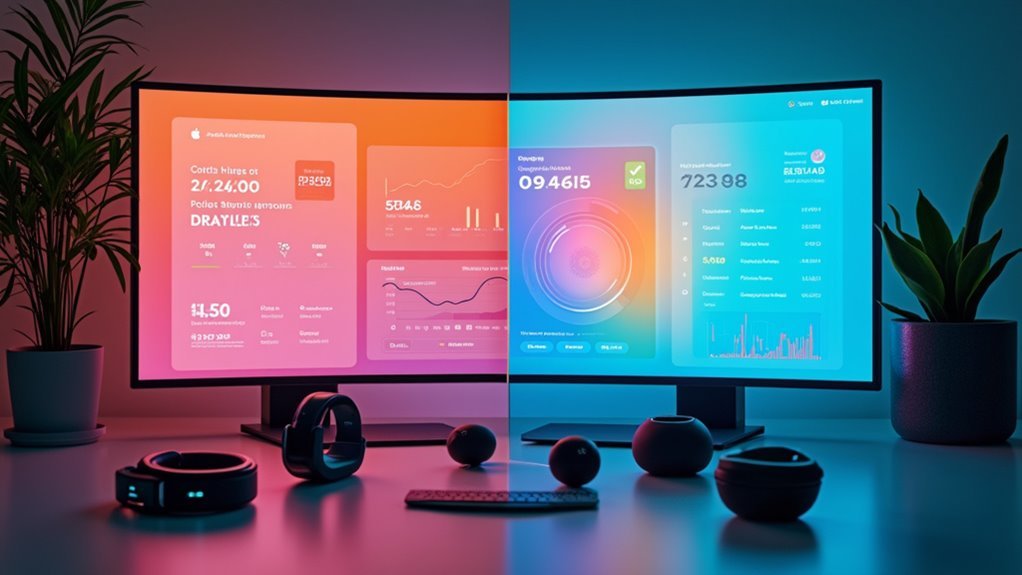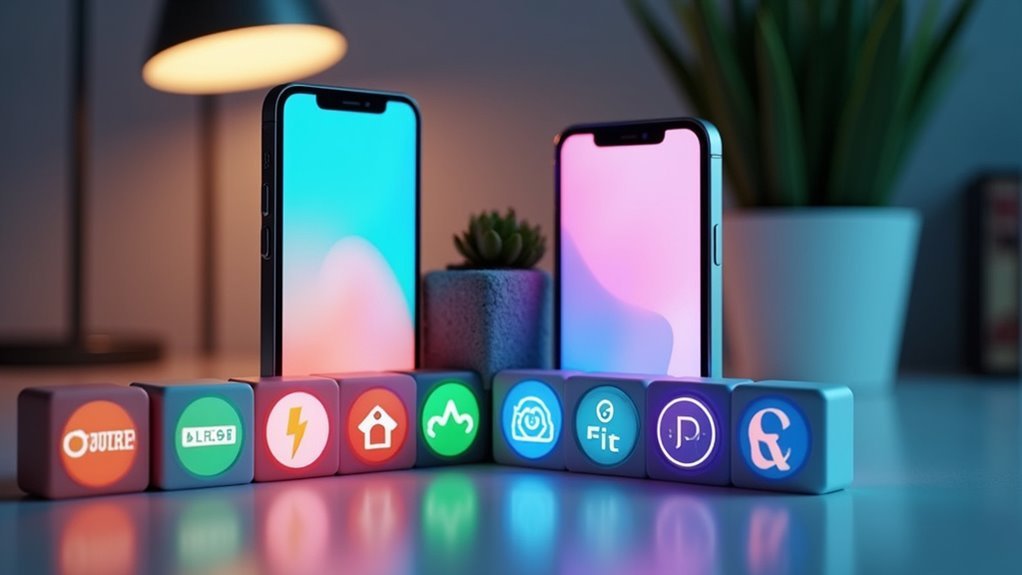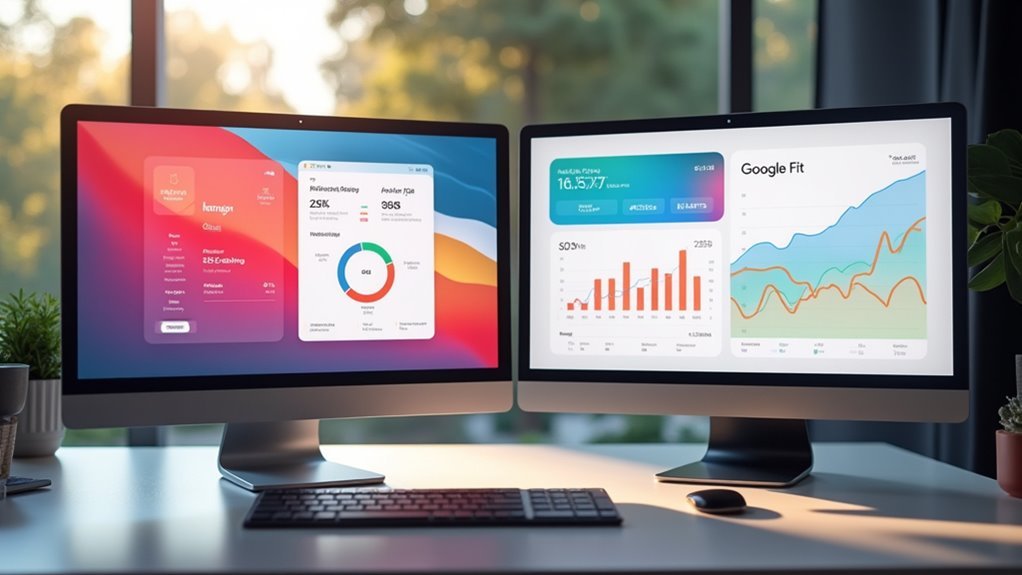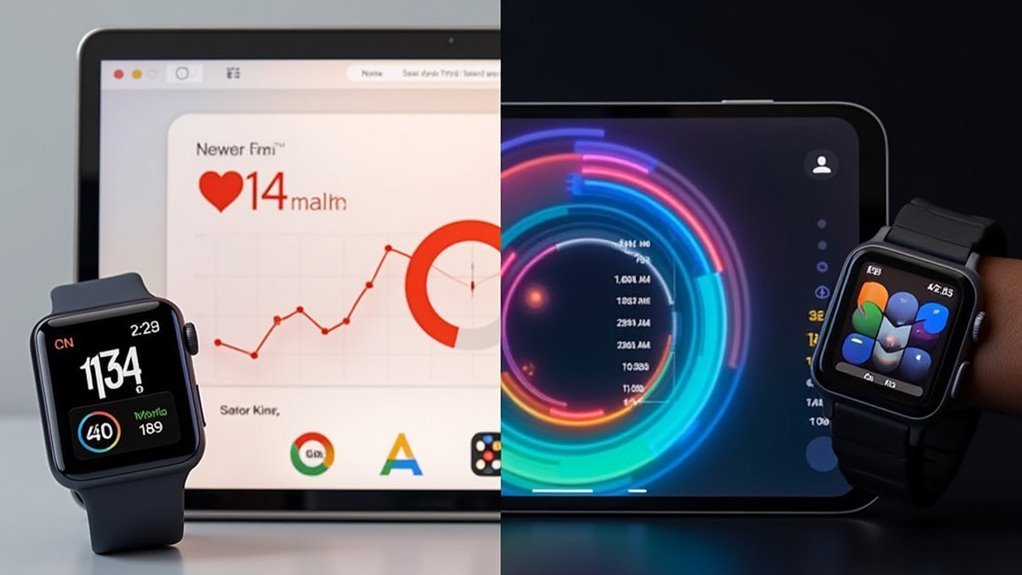You’ll choose Apple Health if you want a privacy-focused, tightly integrated ecosystem that excels at medical data tracking and seamless iOS device connectivity. However, you should pick Google Fit if you prefer cross-platform flexibility with over 75 third-party app integrations and broader device compatibility. Apple Health offers superior data visualization and accuracy, while Google Fit provides gamified experiences and works across operating systems. Your decision ultimately depends on whether you prioritize ecosystem control or open accessibility, and exploring each platform’s specific capabilities will reveal which aligns best with your fitness goals.
Platform Philosophy and Core Health Management Approach

When choosing between Apple Health and Google Fit, you’ll encounter two fundamentally different philosophies that shape how each platform handles your health data.
Google Fit embraces an open, flexible approach that encourages broad integration with third-party developers and supports over 75 fitness apps and trackers. You’ll enjoy compatibility with diverse hardware beyond Google’s own devices.
Apple Health takes a more controlled, privacy-focused stance within its closed ecosystem. While this limits third-party integration, it guarantees stricter data handling and excludes advertisers from accessing your information. The platform allows data sharing with medical researchers while maintaining these privacy standards.
Their data visualization approaches differ considerably too.
Apple Health offers complex, multi-metric comparisons that let you analyze relationships between sleep, activity, and other health factors.
Google Fit provides simpler dashboards with basic activity tracking, focusing on accessibility rather than deep analytical insights.
Data Collection Capabilities and Health Metrics Range
Beyond their philosophical differences, Apple Health and Google Fit demonstrate striking contrasts in their data collection capabilities and health metrics coverage.
You’ll find Apple Health aggregates extensive data from Apple wearables and HealthKit-compliant third-party apps, requiring complete data sharing for consistency. Google Fit integrates with over 75 third-party apps but lacks Apple’s robust direct integration requirements.
Apple Health tracks extensive health metrics including crucial signs, lab results, immunization records, and EHR syncing with healthcare providers. Google Fit focuses primarily on fitness metrics like steps and workout intensity, with limited medical data coverage. Google Fit provides basic step tracking without extensive data analysis and relies heavily on user input for data collection.
- Data Input Flexibility: Apple Health supports both automatic collection and broad manual entry options
- Health Scope: Apple covers extensive medical data; Google emphasizes fitness-focused metrics
- Platform Integration: Apple requires full data sharing; Google offers platform-agnostic but less complete integration
Third-Party App Integration and Developer Ecosystem

Although both platforms offer developer APIs, Apple Health and Google Fit take fundamentally different approaches to third-party integration that directly impact your app choices and data accessibility.
Google Fit integrates with over 75 third-party fitness and nutrition apps, offering extensive ecosystem breadth through its open approach and Health Connect framework. You’ll find thorough documentation covering Android, REST API, and cross-platform scenarios, making it flexible for web and non-mobile platforms.
Google Fit’s open ecosystem connects 75+ apps with cross-platform flexibility, while Apple Health maintains tighter iOS-focused integration controls.
Apple Health remains more restrictive, primarily aggregating data from iOS and App Store apps with no native Android integration. Both platforms require user consent for obtaining, holding, or sharing health data, which affects app functionality and compliance requirements.
However, it’s the gold standard for iOS-specific development with detailed documentation and robust HealthKit APIs. You’ll face platform lock-in challenges, requiring separate development logic for each ecosystem.
Device Compatibility Across Operating Systems
When you’re choosing between Apple Health and Google Fit, you’ll need to evaluate how well each platform works with your specific operating system and devices.
Apple Health excels within the iOS ecosystem but won’t sync with Android devices, while Google Fit offers broader cross-platform support despite some limitations when transferring data from iOS. Within the Apple ecosystem, you’ll find that the Apple Watch provides direct synchronization with Apple Health, making it the most seamless wearable option for iOS users.
Your device compatibility experience will largely depend on whether you’re using wearables and third-party health devices that can sync seamlessly with your chosen platform.
Ios Vs Android Integration
If you’re weighing Apple Health against Google Fit, device compatibility becomes a decisive factor that’ll shape your entire fitness tracking experience.
Apple Health locks you into the iOS ecosystem exclusively. You can’t access your data on Android devices or transfer it outside Apple’s walled garden. Your health information remains tethered to iPhones, iPads, and Apple Watches only.
Google Fit offers broader flexibility across platforms:
- Cross-platform access – Available on Android, limited iOS functionality, and web browsers
- Device switching freedom – Maintain your fitness data when upgrading between Android devices
- Web dashboard availability – Track and analyze your progress from any computer
However, Google Fit’s iOS integration remains limited, and data doesn’t fully transfer between operating systems, creating its own compatibility barriers. Google Fit’s open ecosystem allows data upload from various third-party devices and apps, providing more integration options for diverse fitness tracking setups.
Cross-Platform Wearable Support
Your choice of wearable device can make or break your fitness tracking experience across different platforms.
Apple Watches work seamlessly with Apple Health but offer limited Google Fit compatibility. Meanwhile, Android Wear devices integrate perfectly with Google Fit but can’t directly connect to Apple Health.
If you’re using third-party wearables like Fitbit or Garmin, you’ll need additional apps to sync with Apple Health, while Google Fit accepts data from various Android-compatible devices more easily. Some Android devices may lack built-in hardware pedometer sensors, which can significantly impact the accuracy of your fitness data collection.
Cross-platform apps can bridge the gap between ecosystems, but they’re not always reliable.
Your best bet? Choose wearables that natively support your primary platform, or consider devices like Fitbit that work with both systems through third-party integration.
Third-Party Device Syncing
While both platforms promise extensive third-party integration, the reality of syncing devices across operating systems reveals stark limitations that’ll directly impact your fitness tracking setup.
Apple Health excels with iOS-centric apps like Strava, Garmin, and Peloton, but completely excludes Fitbit devices.
You’ll find robust support for Apple Watch and selected premium wearables, though you’re locked into Apple’s ecosystem. Third-party workout data from compatible apps can sync with the iPhone Fitness app to help users track progress and close activity rings.
Google Fit and Health Connect take the opposite approach, supporting Android’s diverse device landscape including Fitbit and Wear OS watches, but can’t integrate Apple Watch or major iOS fitness platforms.
Key compatibility differences include:
- Apple Health supports Garmin, Oura, Strava, and Peloton but blocks Fitbit
- Google Fit works with Fitbit and Wear OS devices but excludes Apple Watch
- Both platforms require OS-specific app permissions for secure data management
Wearable Integration and Sensor Data Accuracy
When you’re choosing between Apple Health and Google Fit, wearable integration capabilities create one of the most significant differences between these platforms.
Apple Watch exclusively supports HealthKit, limiting cross-platform flexibility but ensuring seamless native integration. Google Fit takes a broader approach, working with Android Wear devices and offering cross-platform support for both Android and iOS users.
However, sensor data accuracy reveals notable disparities. Apple Health integrates more effectively with various health apps and sensors, while Google Fit often struggles with accuracy issues when connecting to other devices. Users frequently experience problems where the daily summary totals don’t match the detailed step counts recorded from third-party fitness apps.
You’ll likely encounter data duplication problems with Google Fit when multiple apps sync simultaneously. Some health metrics like blood pressure require manual input in Google Fit due to limited sensor integration, whereas Apple Health provides more extensive automated data collection.
User Interface Design and Health Data Visualization

Although both Apple Health and Google Fit prioritize user-friendly design, their interface philosophies differ markedly in how they present your health data.
Apple Health embraces minimalistic elegance with its clean white background and classic aesthetic. You’ll navigate through broad health categories via a bottom bar, accessing extensive trends through detailed line graphs and bar charts.
Apple Health’s minimalistic design philosophy creates an elegant user experience through clean interfaces and comprehensive data visualization.
The platform excels at aggregating diverse data types—from nutrition to medical records—maintaining uniform design language throughout. Apple Health also includes a dedicated Health Records section for storing and organizing medical information from healthcare providers.
Google Fit takes a vibrant, gamified approach with bold colors and card-based layouts. You’ll experience:
- Dynamic activity rings that animate in real-time
- Android widget support for home screen data display
- Tabbed navigation for quick switching between metrics
While Apple Health emphasizes historical trends and holistic health views, Google Fit prioritizes immediate feedback and fitness-focused engagement.
Gamification Features and Motivation Strategies
Beyond visual design, both platforms employ distinct gamification strategies to keep you motivated and engaged with your fitness journey. Apple Health offers a thorough approach with virtual badges, personalized challenges, and social competitions that leverage peer pressure. You’ll receive tailored recommendations based on your Apple Watch data, making goals realistic and achievable.
Google Fit takes a simpler approach, focusing on activity tracking with movement points and basic goal-setting features. While you can share progress with friends, it lacks Apple’s extensive gamification elements.
Apple’s gamification approach transforms mundane fitness targets into exciting milestones, utilizing the psychology of motivation to enhance your overall fitness experience.
| Feature | Apple Health | Google Fit |
|---|---|---|
| Virtual Achievements | Thorough badges | Basic points |
| Social Features | Challenges & competitions | Simple sharing |
| Personalization | AI-driven recommendations | Limited customization |
| Device Integration | Full Apple Watch sync | Basic tracking |
| Motivation Strategy | Recognition-based rewards | Goal-oriented feedback |
Apple’s strategy proves more engaging through recognition and social comparison features.
API Support and Developer Tools
Both platforms offer developer tools for health data integration, but they take fundamentally different approaches to API access and implementation.
Apple Health relies on device-level HealthKit APIs, requiring direct iOS app integration through Xcode. You’ll access data locally through thorough query systems, but there’s no cloud-based API available.
Apple provides robust documentation, sample code, and testing tools while emphasizing privacy-first protocols with user consent requirements. Developers can also utilize ResearchKit and CareKit frameworks to create comprehensive health science research applications that scale globally.
Google Fit offers more flexible integration options:
- Cloud-based REST API for server-to-server communication
- Android SDK for native app development
- Web-based OAuth authentication system
You’ll find Google Fit’s approach more accessible for cross-platform development, while Apple’s ecosystem delivers tighter integration within iOS devices but requires platform-specific implementation expertise.
Cross-Platform Compatibility and Data Portability
You’ll face significant limitations when trying to use these health platforms across different device ecosystems, as Apple Health exclusively works on iOS while Google Fit operates on Android devices.
Your data won’t easily transfer between the two platforms, creating portability challenges if you switch from an iPhone to an Android device or vice versa. Google Fit does have an advantage in that it connects with Apple Health and supports various compatible apps, providing some cross-platform functionality.
However, you can work around some of these restrictions through third-party apps that sync data between platforms, though this requires additional setup and may not capture all your health information.
Device Ecosystem Limitations
When choosing between Apple Health and Google Fit, you’ll quickly discover that ecosystem boundaries create significant barriers to cross-platform compatibility and seamless data sharing.
Apple Health remains exclusively locked to iOS and Apple Watch devices, while Google Fit primarily serves Android users. Though Google Fit offers an iOS app, you’ll find it lacks full sensor integration and native functionality compared to its Android counterpart.
Your wearable device choices become severely restricted by platform boundaries:
- Apple Watch won’t sync with Google Fit on Android devices
- Google Pixel Watch can’t integrate with Apple Health
- Cross-brand devices like Fitbit require third-party workarounds
You’ll face significant challenges transferring data between platforms, as no native synchronization exists. Third-party services become necessary for basic data portability, often compromising data fidelity and creating fragmented health tracking experiences.
Third-Party Data Syncing
Several third-party solutions attempt to bridge the data syncing gap between Apple Health and Google Fit, though each comes with notable limitations and compromises.
You’ll find apps that can export your Apple Health data and import it into Google Fit, but this process isn’t seamless or real-time. Data duplication becomes a common issue when you’re syncing across platforms, creating confusion in your fitness tracking.
Google Fit’s API integration allows better cross-platform data aggregation from multiple sources, while Apple’s HealthKit remains iOS-exclusive.
If you’re using Google Fit on iOS, you can only read data from other apps—you can’t write data back to your device. This one-way limitation considerably impacts your ability to maintain consistent health records across different platforms and devices.
Fitness Tracking Accuracy and Performance Metrics
Accuracy differences between Apple Health and Google Fit become apparent when you compare their step counting and activity tracking performance.
Google Fit can show up to 50% lower step counts than Apple Health during identical activities, primarily because Google Fit focuses on “active time” with fast-paced steps while Apple Health counts all steps plus elevation changes.
Key accuracy differences include:
- Step counting algorithms: Apple Health’s integration with Apple hardware provides more reliable step tracking than Google Fit’s open platform approach.
- Heart rate monitoring: Apple Health aggregates data from multiple sources while Google Fit relies solely on connected devices.
- Activity scope: Google Fit tracks 100+ exercise types but Apple Health offers broader health metric integration.
Apple Health’s tighter hardware integration generally delivers superior tracking accuracy across multiple fitness metrics. Google Fit compensates for potential accuracy limitations through its points system, which rewards users based on the intensity and duration of their physical activities.
User Experience Challenges and Sync Reliability
Beyond tracking accuracy, you’ll encounter distinct user experience philosophies that shape how each platform engages with your fitness journey.
Google Fit emphasizes gamification with goal-oriented tracking, streaks, and heart points developed through WHO collaboration. You’ll find more social features that encourage engagement through competitive elements and rewards.
Apple Health takes a streamlined approach with a user-friendly interface that’s praised for simplicity and tight iOS integration. However, you’ll sacrifice some gamification elements for this clean design.
Regarding sync reliability, Apple Health excels with seamless data continuity across Apple devices through iCloud integration and faster synchronization speeds. The platform’s centralized health data approach ensures all your fitness metrics are consolidated in one secure location.
Google Fit offers broader cross-platform compatibility but faces occasional sync issues across multiple devices. Apple’s ecosystem-centric approach guarantees more reliable performance within its walled garden.
Future Development Roadmap and Market Positioning
While both platforms continue evolving their capabilities, their future trajectories reveal distinct strategic priorities that’ll directly impact your long-term fitness tracking experience.
Google Fit’s positioning centers on cross-platform accessibility and data unification. With over 100 million Android downloads and strong performance in markets like Japan and India, Google’s leveraging its Fitbit acquisition to compete against Apple’s ecosystem dominance. The platform is transitioning towards Health Connect by June 30, 2025, representing a significant shift in Google’s data aggregation strategy.
Apple Health maintains its advantage through tight iOS integration and privacy-focused development. The platform benefits from Apple Watch’s market share and strong brand loyalty among iOS users.
Key strategic differences you’ll encounter:
Understanding these fundamental strategic differences will help you choose the platform that best aligns with your fitness goals and device preferences.
- Market Approach: Google targets broad accessibility while Apple focuses on premium ecosystem integration
- Data Philosophy: Google emphasizes unified multi-device data; Apple prioritizes secure, privacy-first storage
- Wearable Strategy: Google’s expanding through acquisitions; Apple’s deepening existing hardware integration
Frequently Asked Questions
Can I Transfer My Health Data When Switching From Iphone to Android?
You can transfer some health data when switching from iPhone to Android, but it’s complicated. Apple Health exports data in XML format, which doesn’t directly import into Google Fit, requiring third-party solutions.
Which Platform Offers Better Privacy Protection for My Personal Health Information?
Apple Health offers better privacy protection since it stores your data primarily on your device with optional encrypted iCloud backup, while Google Fit automatically syncs all your health information to Google’s cloud servers.
Do Apple Health and Google Fit Work Without Owning a Smartwatch?
You can use both Apple Health and Google Fit without a smartwatch. They’ll track basic metrics like steps using your phone’s sensors, but you’ll miss advanced features like heart rate monitoring.
How Much Storage Space Do These Health Apps Require on My Phone?
Apple Health storage varies dramatically from 1.6GB to 46GB depending on your usage and data retention. Google Fit requires minimal space, typically under 100MB, making it lighter on your phone’s storage.
Can I Use Both Apple Health and Google Fit Simultaneously?
You can run both apps simultaneously on your device. However, they won’t directly sync data with each other. You’ll need third-party apps or manual input to share information between Apple Health and Google Fit effectively.
In Summary
You’ll find both platforms excel in different areas. If you’re deeply embedded in Apple’s ecosystem and prioritize seamless integration with premium devices, Apple Health’s your best bet. However, if you need cross-platform flexibility, extensive fitness tracking, and broader device compatibility, Google Fit delivers better value. Your choice ultimately depends on whether you value ecosystem cohesion over universal accessibility and tracking versatility.





Leave a Reply